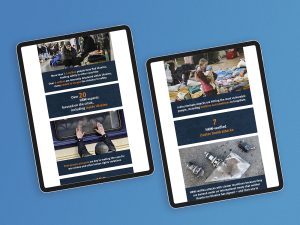New donor acquisition is the most expensive area of any fundraising program. But to combat natural donor attrition – and it will happen no matter how hard you try to fight it – it is critical to replace lapsed donors with new donors. This keeps your file healthy and, most importantly, grows your pool of prospects for mid-level, planned gifts and large donors.
If you already have an acquisition program in place, you likely have a tried-and-true control package that has worked and you can count on for good results. But continuously testing against your control is the best way to ensure messaging is still relevant and that you are optimizing results. What might have worked years ago might no longer be valid today so it’s important to make sure that your package and message evolves with the time, and you avoid package fatigue. It’s smart to continuously test and re-test.
The key point is to look at your annual acquisition plan as a whole. What is your budget? How many campaigns do you have? When are you mailing? What is the volume? Once you have a general plan, you can begin to strategize on test options.
If it is cost prohibitive to develop and test an entirely new package – even the slightest change can make a big difference in results.
Test for Seasonality: The best times for acquisition are generally during the fall season and first quarter of the calendar year (January – March). But there could be strong pockets during other times of the year for your organization. This is a very simple and low-cost method to see what time of year is optimal and when your organization’s message resonates best. The best part is you can mail the same control package so you avoid the additional cost of creating a separate package.
Package Enhancements: There are many different ways to improve on your control without driving up your costs. By looking carefully at each component, you can consider low-cost treatments that could make a big impact, such as:
- Using live stamps on the outer envelope.
- Changing the teaser or a testing a plain no-teaser envelope.
- Use faux handwritten notes on the letter, different PS notes, and call-outs in letter and reply.
- If there are additional components like an insert, perhaps look at using different colors or refreshing the design.
Cost-cutting Methods: On the flip side, there are ways to test that could help lower the cost of the control:
- If you are using a closed-face envelope, perhaps consider testing a window envelope. If it does not change the response, then you will know that switching to a window won’t have a negative impact but instead will lower the package cost and therefore improve overall ROI.
- Are you using a separate reply form? Test a letter with attached reply to see if that affects response. This will generally cost less than printing a separate reply so if it works, then that’s another way to help your cost and ROI.
- Are you printing any pieces in four colors? Then try converting them to two-color and test it. Again, if it does not have a negative impact on your results, then shifting to fewer colors can help your bottom line.
Combo printing: Also known as combination run or gang run, combo printing entails printing multiple small jobs all together to reduce the cost of each job. By combining all the jobs into one run, it reduces press set-up charges and paper waste, and distributes the fixed costs across all the different jobs and not applied to just one job. This is when it is important to evaluate your annual acquisition plan and strategize the different tests you want to accomplish:
- For example, you can test cost-saving methods earlier in the year so those results come in first, allowing you to roll out early the following year.
- Or if you test seasonality, then you can print your control in advance so it is ready to drop when the mail date arrives.
- Another bonus with combo printing is because everything will already be printed, you get to stay way ahead of schedule. With some coordination and early planning, you can get the most bang for your buck by pre-printing for the full year.
Bid: One other critical factor to keep your costs in line is to bid out the printing and production of your acquisition campaigns with at least three different vendors to find the best pricing. You could be surprised by the varying degree of each vendor’s pricing so this is a good way to ensure that you are getting a fair estimate. In addition, by forming relationships with various vendors and building credibility for your organization, it can also help with the pricing that they offer.
By implementing low-cost test elements, you can add value to your control package and acquisition program, and bring in those much-needed new donors.
Case Study
For our client Conquer Cancer, we have put together a solid control package for them through a series of testing. But just because we have a current strong performer doesn’t mean we stop testing. Even with a limited budget we have been able to obtain strong gains in their program.
We combo printed early in the year with a variety of tests. We then left enough time to read results for our Spring campaigns and set up our next series of tests, taking advantage of combo printing for Spring and Fall. To date, we have helped the organization bring down the acquisition cost by 6% as well as the cost per new donor by 31%, lifting response by 33% compared to the previous year.

Looking to test new elements in your acquisition but don’t want to break the bank? We would be happy to help you put together a plan. Reach out to Diana, one of our Senior Account Directors of Direct Mail at diana@faircomny.com.




